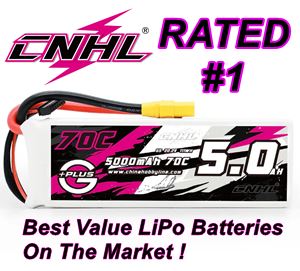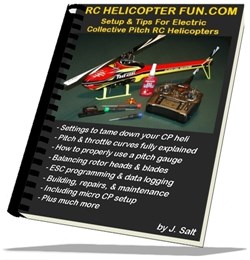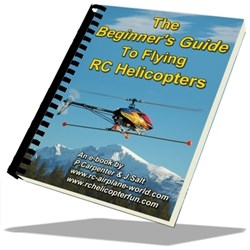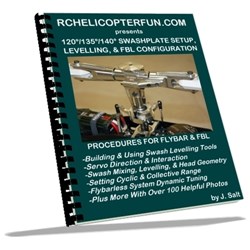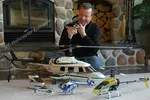Nitro RC Helicopter Mess & Cleaning Solutions
by John Salt
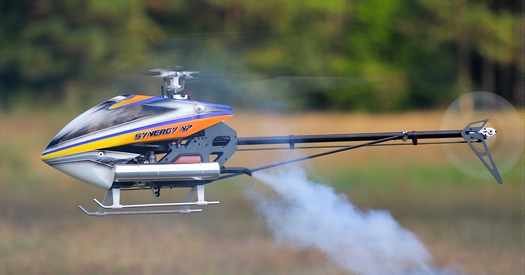 Nitro Exhaust Contains A High Amount Of Messy Oil That Gets EVERYWHERE!
Nitro Exhaust Contains A High Amount Of Messy Oil That Gets EVERYWHERE!Nitro engines create an awful amount of oily mess in and around your nitro RC helicopter. You can’t prevent it, but you can divert some of it and minimize its long term negative effects.
So why is nitro exhaust so bloody messy anyway? Well, nitro model fuel contains a very high oil mix ratio of about 20% oil! That's 1:5 oil to fuel mix ratio.
Most gasoline 2-stroke engines on the other hand use oil mix ratios in the 1:20 -1:50 range. There's not much oil in the exhaust and what's in there is mostly burnt off in the combustion process.
This is not the case with nitro engine exhaust. Most of that high oil mix concentration makes it through the exhaust and it gets everywhere when it leaves the engine in a fine atomized fog. This fog will get into every nook and cranny of your nitro RC helicopter and will condense into a nice slimy layer of oily goo.
Protecting Receivers, Servos, Gyro/FBL Systems From Nitro RC Helicopter Mess
This oil is generally not a problem for most of your RC helicopter, but it can hurt your electronics; specifically the receiver, servos, and gyro / FBL unit. You should protect these components as much as possible.
It never hurts to cover your receiver, battery pack, and gyro/FBL system along with any other electronics such as glow divers and voltage regulators in small plastic bags/similar to help keep the oil film off them.
You should consider getting water resistant servos as well.
These should be called oil resistant servos because not many people fly their RC helicopters under the water – at least not intentionally. Many quality servos these days are water resistant, having case gaskets along with screw, output shaft & wire seals to prevent water or oil from getting inside.
If you don’t have water proof servos you can open them up and apply a very small quantity of automotive silicon gasket maker to the two mating halves of the servo case and a little dab of silicon where the servo wires enter the servo and around the case screw heads.
Just make sure you don’t get any silicone on the circuit board or the gears. Don’t worry, silicone won’t glue the servo together and you will be able to pull it apart again if you have to.
Another thing nitro oil will do, is soften and degrade the adhesive layer on double sided tape (you know, the stuff that holds your FBL system firmly to your heli). This can be a disaster if the FBL system or tail gyro comes loose in flight. Always keep an eye on those components for degrading of the double sided tape that keeps them firmly attached to the helicopter. Pretty much a pre-flight check item on any nitro power RC helicopter in my opinion.
Oil goo on all the moving mechanical parts of your nitro RC helicopter of course won’t do any harm and in some cases will actually do a little good to keep things lubricated and moving freely. Problem is oil also attracts dirt and in dirty/dusty flying areas, all that dirt sticking to your machine can and will cause issues so you should try to clean it off the best you can. More on cleaning shortly...
Divert The Exhaust
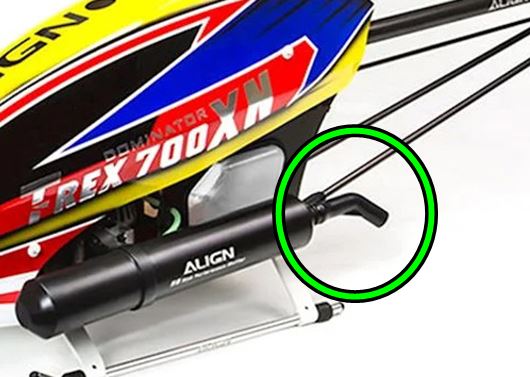 Nitro RC Helicopter Exhaust Diverter
Nitro RC Helicopter Exhaust DiverterAs shown above, using some sort of exhaust diverter on the back end of your muffler, angled down and slightly outward helps keep a good deal of the oily exhaust away from the helicopter.
These exhaust diverters are generally made from silicone and are clamped to the outlet nib on the muffler.
While flying forward, very little nitro exhaust oil will get on the main body of the helicopter using a diverter like this. However flying backwards, sideways on the muffler side, or while hovering inverted, lots of oil will still get on your machine.
Cleaning time.
Cleaning The Nitro RC Helicopter Mess
After a day of flying, carefully wipe down your nitro RC helicopter with some paper towels, blue shop towels or microfiber towels along with a cleaning solution to remove the oil residue off the heli and the main and tail rotor blades.
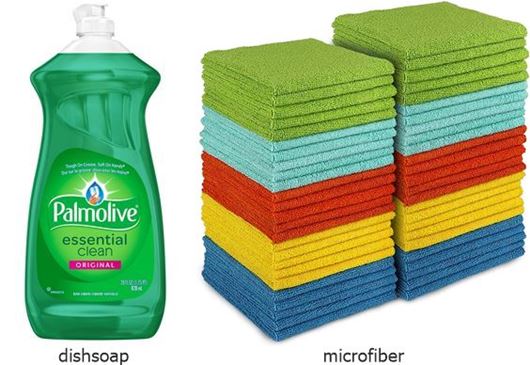 Dish Soap & Microfiber Towels Are Great For Cleaning Nitro RC Helicopters
Dish Soap & Microfiber Towels Are Great For Cleaning Nitro RC HelicoptersI personally like using a wee squirt of any dish soap into a spray bottle of water for the cleaning solution I use with the paper/shop or microfiber towels to clean this nitro RC helicopter mess. The microfiber towels can of course be used over and over for cleaning after washing them.
Dish soap is both inexpensive and cuts through nitro oil residue amazingly well. Experiment with the soap/water ratio, but I find just a single squirt in a regular spray bottle of water does a wonderful job and doesn't leave any soapy residue behind.
If you want this light dish soap solution to cut through the oil and dry even better, toss in a little isopropyl alcohol as well, but it's certainly not required.
The one thing to watch out for here is if you land in or hover over any sand – there will be little bits of sand stuck to any oily surface on your heli which can scratch the heli if it's stuck in the cleaning rag afterward. Try to get the sand off first (most will be on the skids) and then use a different rag for the remainder of the cleaning.
You should also check the area around your engine carburetor to make sure there are no sand grains near the air intake. To clean the engine and engine area if this happens or when it's just getting really saturated & dirty with oil residue, I like to use methyl hydrate.
I plug the carburetor hole and spray a liberal amount of methyl hydrate that I put into an ordinary squirt bottle or syringe all over the engine and engine area. I then blow it dry with compressed air and things are squeaky clean again.
Methyl hydrate is safe for everything on your helicopter and evaporates quickly. Do not use acetone or automotive carb or brake cleaners. These chemicals will melt certain plastics and destroy the finish of your helicopter.
A clean heli is a happy heli!
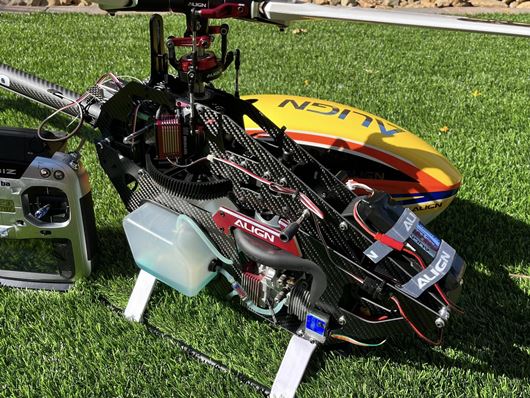 Clean & Happy Nitro RC Helicopter
Clean & Happy Nitro RC Helicopter
